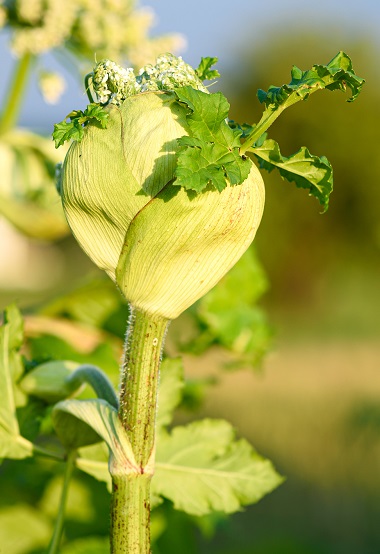What is giant hogweed?

Giant hogweed is an invasive plant, meaning it is not native to Canada. It has dangerous, toxic sap and can spread quickly, putting people at risk of serious injury.
Giant hogweed is a large plant that can grow up to 5 metres tall with stalks up to 10 centimetres around. It has large, saw-like edges on its leaves, and distinctive purple blotches and sharp bristle-like hairs on its stalks. When it blooms (which usually happens around mid-June), it has small white flowers that cluster together in an umbrella shape.
For a guide on identification of giant hogweed and other similar looking plants, visit:
- www2.gnb.ca/content/dam/gnb/Departments/10/pdf/Agriculture/GiantHogweed.pdf (PDF, 865 KB)
- https://fviss.ca/lookalike-hogweed
- https://bcinvasives.ca/wp-content/uploads/2020/12/Giant_Hogweed_TIPS_2017_WEB.pdf (PDF, 758 KB)
Where can you find giant hogweed?
Giant hogweed grows where the soil is moist, such as near creeks and in ditches. It can also grow in pastures, open woodlands, roadsides and unmaintained vacant lots. It prefers to grow in undisturbed areas with high sunlight. In B.C., giant hogweed is mainly found near the coast, including throughout Vancouver Island, the Gulf Islands and the Lower Mainland.
Giant hogweed can grow very quickly, reaching up to one metre high in the first year. It also can spread quickly. Each plant makes tens of thousands of seeds. The seeds usually fall within 10 metres of the plant but can also be carried by running water for up to 3 days.
Why is it dangerous?
Giant hogweed has a clear sap in its stalk, stems and leaves. If this sap gets on your skin and is then exposed to sunlight or UV light, it will cause redness, swelling, blisters or burns. Blisters may take up to 48 hours to appear. After about a week, the affected skin may darken or scar, which can last for months or years. If the sap gets in your eyes, it can lead to temporary or permanent blindness.
What if I touch the sap?
- Carefully remove any clothing that may have contacted the sap
- Immediately wash the affected skin with soap and water
- Keep the affected skin away from UV and sunlight for at least 48 hours, even if you do not have symptoms
- If you start to get a rash or blisters, seek medical care. You may be given anti-inflammatory cream (such as a 0.5% hydrocortisone cream) to reduce irritation
- Wear sunblock with a Sun Protection Factor (SPF) of at least 30 on the affected skin for at least a few months after exposure
- If the sap gets into your eyes, flush them with clean water for at least 10 minutes, put on sunglasses with dark lenses and seek medical care as soon as possible
- Clothing with sap on it can be washed in the laundry
What should I do if I see giant hogweed?
If you see giant hogweed, report it as an invasive species. For more information, visit www2.gov.bc.ca/gov/content/environment/plants-animals-ecosystems/invasive-species/reporting-invasive-species.
Once you report that you have seen giant hogweed, the response depends on where you live. Your municipality or regional district will either remove the plant or provide you with information about how to remove it. It’s best to have a professional remove giant hogweed if your municipality or regional district does not provide this service. There may be special requirements for removal or disposal of giant hogweed in your area.
In general, it’s best to remove giant hogweed in late April or early May because young plants will be smaller and the temperature will be cooler making protective clothing more comfortable to wear. Remove any flower heads when they are white. If they are green, they have already started to produce seeds that can spread when you remove the flowers.
Do not compost or burn giant hogweed. Incomplete composting or burning does not kill the plant, which can then spread through the compost or surrounding soil. Do not purchase or plant giant hogweed in your yard or garden.
For more information on removing giant hogweed, visit www.quebec.ca/en/housing-territory/healthy-living-environment/identifying-and-getting-rid-of-giant-hogweed.
What should I wear while removing giant hogweed?
It’s best to have a professional remove giant hogweed.
If you choose to remove it yourself:
- Be very careful not to touch any part of the plant with any part of your skin
- Ensure sure your skin is entirely covered with thick, water-resistant clothes, footwear and gloves
- Wear goggles to prevent sap from getting in your eyes
For more information
- Information for workers: www.worksafebc.com/en/resources/health-safety/information-sheets/toxic-plant-warning/severe-skin-damage-from-giant-hogweed-heracleum-mantegazzianum?lang=en
- Additional information on management: https://bcinvasives.ca/wp-content/uploads/2020/12/Giant_Hogweed_TIPS_2017_WEB.pdf (PDF, 758 KB)
